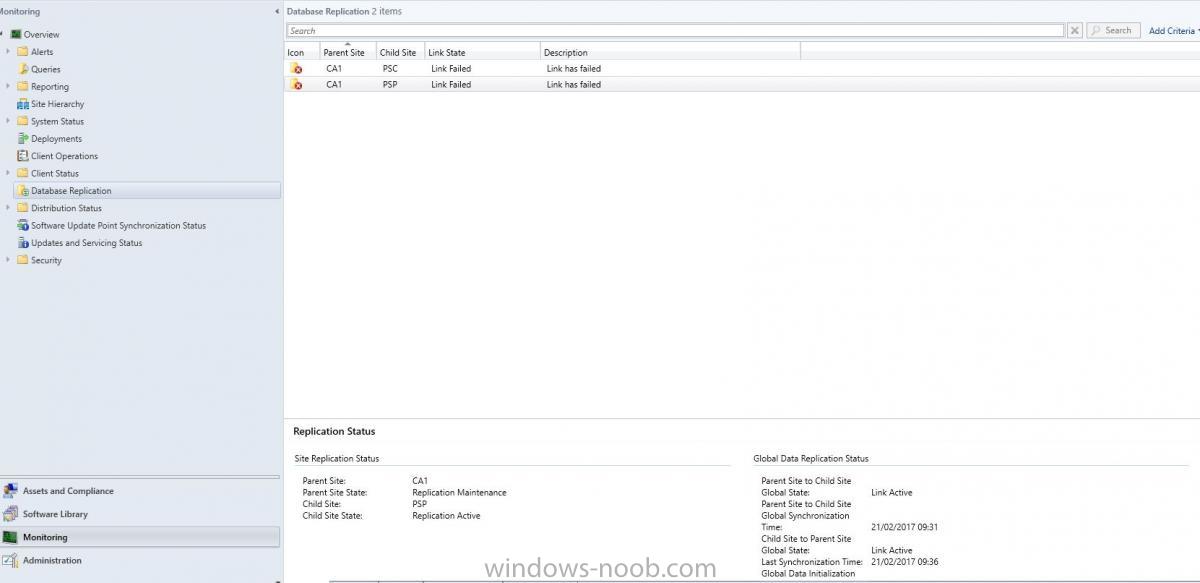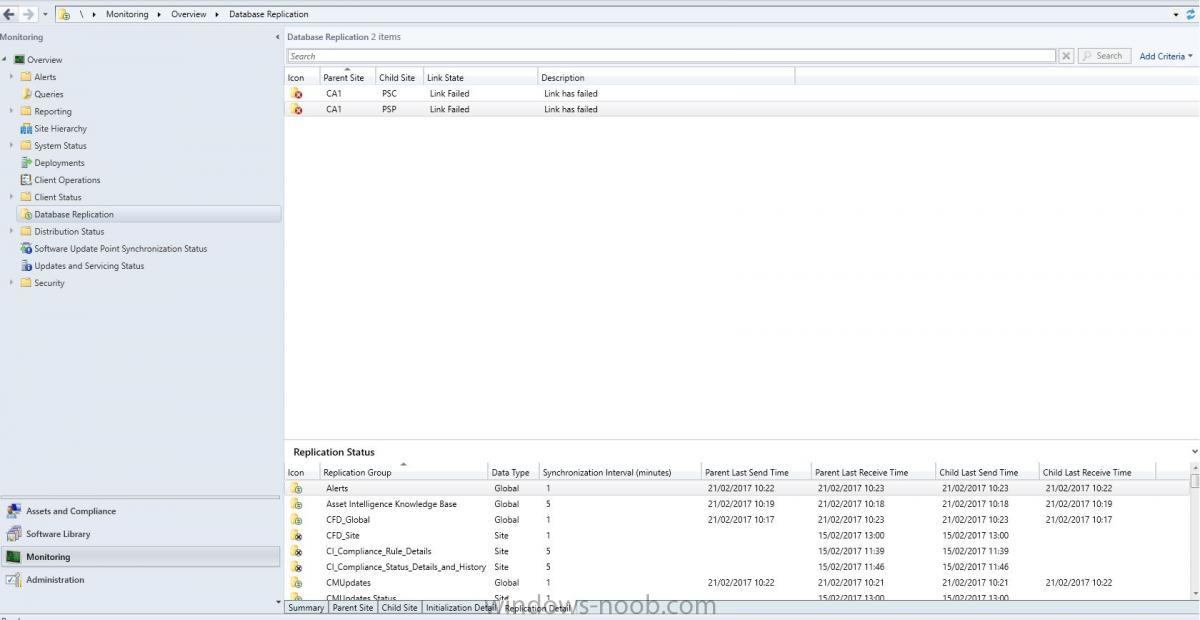Search the Community
Showing results for tags 'replication'.
-
Hi, We have just update our 3 SCCM servers with CU 1606. We have a CAS and 2 primary site servers. Since the update the CAS replication has gone into "Replication Maintenance" The global replication ist still working but the site replication has failed since the update. When we run the Replication Link Analyser it is all green, I believe it doesn't realise there is an issue as no site replication has taken place and this is just reporting on pre-update info. We have run the fowling in SQL and there are a number of entries that aare not 7: update RCM_DrsInitializationTracking set InitializationStatus = 7 where ReplicationGroup in (select replicationgroup from vReplicationData where ID in (select ReplicationID from RCM_ReplicationLinkStatus where SnapshotApplied <>1))and InitializationPercent not in (0,100) Has anyone come across this or can help? I have attached a couple of files that may help explain the issue. Thanks Kevin
-
- CAS
- Replication
-
(and 4 more)
Tagged with:
-
As part of our companies SCCM 2012 design process, I'm tasked with attaining some network traffic modelling for a CAS design and a single Primary Site design. Scenario: 10,000 managed devices spread in over 22 locations globally 1x CAS 2x Primary Sites (5,000 devices per site) What would the estimated size of the databases be and the amount of network traffic (Primary "A" <-> CAS <-> Primary "B"). I've tried Googling for this information and couldn't find definitive numbers or even ball park numbers to do calculations. Any assistance is much appreciated.
-
Hello all, Just wanted to say a big thanks to Niall, and the rest of the community, this website has been excellent at helping me out over the years with all ConfigMgr related issues! definitely wouldn't be the engineer I am today without all your help I have a question regarding Site Replication & Thread limits. My organisation has a large SCCM environment, with a CAS and 6 primary sites, with multiple secondary sites under each primary. We are trying to optimise the total threads & threads per site to increase performance of the replication of data across the hierachy. I've been going through a lot of the TechNet documentation regarding bandwidth management etc (mainly https://technet.microsoft.com/en-gb/library/gg712701.aspx#BKMK_BandwidthBetweenSites) and cannot find what I am looking for. My questions are: 1. Does the 'Sender' settings (Properties of a site) only affect File based replication? or does it also affect database replication? 2. The 'warning' in the above link which states: "When you configure rate limits to restrict the bandwidth use on a specific file replication route, Configuration Manager can use only a single thread to transfer data to that destination site. Use of rate limits for a file replication route overrides the use of multiple threads per site that are configured in the Maximum concurrent sendings for each site." does this only affect file replication routes? or does the same apply for database replication routes, and also sending to remote distribution points? 3. Can anyone recommend / advise any 'best practice' or recommendations for optimising the concurrent thread settings? any links or advice is welcome Thanks Dave
-
- Replication
- Optimisation
-
(and 4 more)
Tagged with:
-
Complex to me, anyway. We've got two DPGs set up. DPG1 contains all of our existing DPs. It has all software assigned to it. A large portion is set as High Priority packages (don't ask... this is a client and something to fix). Many packages appear to still be replicating. DPG2 is new. We're replacing some of the existing DPs with new hardware/Server 2012. We have only the software we feel is mandatory at each site set to replicate to this DPG. New DPs are not part of DPG1 - only DPG2. We also have bandwidth throttling going on from our Primary Site (where we create all packages) to each other site. We have the DP where we create packages set to 7 outbound connections at a time. I know that packages replicate according to priority. I also know just one package is sent from the central DP to the branch office DPs when bandwidth throttling is turned on. My question/confusion is when will the new DPs in the new DPG start getting software? Does the replication that needs to complete for the DPs in DPG1 need to happen before the new DPs in DPG2 will get anything pushed to them? Is there a way to stop the replication of specific packages in DPG1 if they have not completed?
-
DPM Manual Creation of Initial Data Set
matthewjfazio posted a question in System Center Data Protection Manager
I've got several remote office locations with file servers containing a good amount of data, but they have very poor (3Mbps) WAN connections. I've been tasked to set up DPM to back up these locations. Due to the size of the data and the lack of bandwidth, I'm going to need to get the techs out there to copy the data portions of the servers onto USB drives and send them to me so I can import them into the DPM storage here. But I’m having some problems finding the document that instructs a tech how to copy the initial data replica to a USB drive, then docs on how I can import this data. I have found this: http://technet.microsoft.com/en-us/library/jj642916.aspx but it talks about server-to-server copying, which previously mentioned is not something we can not do due to bandwidth issues. We need to copy to USB drive, then ship the drive to me for import into DPM. There’s some mention of doing this to tape (then importing to DPM) as well, but I can’t find more details either… it’s sort of weird, like the documentation or help files on TechNet are incomplete. Like take a look at this link http://technet.microsoft.com/en-us/library/hh757818.aspx -- it’s pretty useless! Has anyone done this yet? Can anyone please point me in the right direction? -
Linked Deployment Share - Is this best practice?
crane_IT posted a question in Microsoft Deployment Toolkit (MDT)
Ok, currently, I have our Deployment Share on our regular deployment server (MDT001) and I've created a Linked Deployment Share on a network location in our Northern branch. Their x86 Linked Deployment Share boot image is working and all the information seems to be pulling from our database (MDTDB) and populating the information. However, I'm trying to set them up with a x64 boot image for doing our Engineering Workstations, but it just sits and asks for a role. It seems to be seeing it enough to know which roles are available, but it's not seeing my database that tells it which role and which applications to pull from. I thought I've copied all the bootstrap.ini settings from the x86 image that does work, but it's still not working. Can anyone tell me what I might be missing? On a bigger picture, am I using the Linked Deployment Share as it was intended? Should I create a database and store it locally on the remote server in our Northern branch, and if so, how do I do that? -
Hello everyone, Wondering if I could get some advise. I have 2 servers 1) Windows server 2008 R2 Roles Active Directory Domain Controller (GC) DNS Files services 2) Windows Server 2003 Roles DHCP Print Server DNS Domain Controller I want to move the following roles over to the Windows 2008 server ( DHCP, Print Services) and I want to wipe out the Windows 2003 server and upgrade to Windows 2008. Do i need to demote the Windows Server 2003 first from being a DC, then wipe out? Thank s for help and advice. I have attached a copy of some of the roles, any help and advice will be great.
- 2 replies
-
- global catalog
- domain controller
-
(and 2 more)
Tagged with:
-
Hello! As i understand, when "Binary Differential Replication" is checked, then when you make changes in a package and then updates the distribution points, only the changes will be transfered and therefore you wont use so much bandwidth as would have to if you didnt have this option checked. I just wonder when, in wich scenario would i NOT want this? I cant figure out why its a choise? I can only see advantages PIC: http://img841.imageshack.us/img841/1713/binarydifferentialrepli.jpg // Barty
- 2 replies
-
- Binary
- Differential
-
(and 1 more)
Tagged with:





